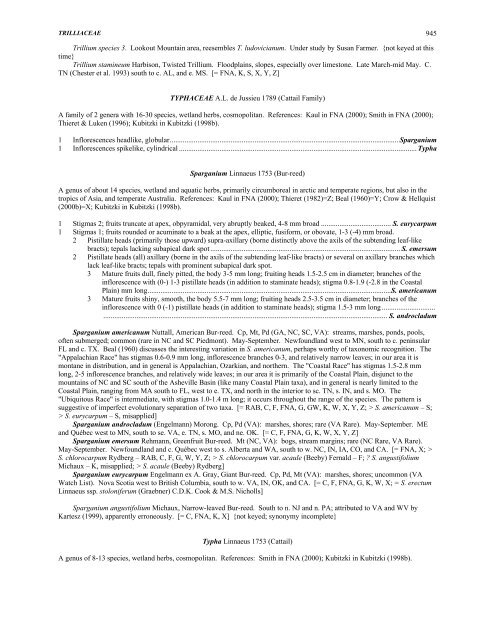Part 7 - UNC Herbarium
Part 7 - UNC Herbarium
Part 7 - UNC Herbarium
You also want an ePaper? Increase the reach of your titles
YUMPU automatically turns print PDFs into web optimized ePapers that Google loves.
TRILLIACEAE 945<br />
Trillium species 3. Lookout Mountain area, reesembles T. ludovicianum. Under study by Susan Farmer. {not keyed at this<br />
time}<br />
Trillium stamineum Harbison, Twisted Trillium. Floodplains, slopes, especially over limestone. Late March-mid May. C.<br />
TN (Chester et al. 1993) south to c. AL, and e. MS. [= FNA, K, S, X, Y, Z]<br />
TYPHACEAE A.L. de Jussieu 1789 (Cattail Family)<br />
A family of 2 genera with 16-30 species, wetland herbs, cosmopolitan. References: Kaul in FNA (2000); Smith in FNA (2000);<br />
Thieret & Luken (1996); Kubitzki in Kubitzki (1998b).<br />
1 Inflorescences headlike, globular............................................................................................................................ Sparganium<br />
1 Inflorescences spikelike, cylindrical ................................................................................................................................. Typha<br />
Sparganium Linnaeus 1753 (Bur-reed)<br />
A genus of about 14 species, wetland and aquatic herbs, primarily circumboreal in arctic and temperate regions, but also in the<br />
tropics of Asia, and temperate Australia. References: Kaul in FNA (2000); Thieret (1982)=Z; Beal (1960)=Y; Crow & Hellquist<br />
(2000b)=X; Kubitzki in Kubitzki (1998b).<br />
1 Stigmas 2; fruits truncate at apex, obpyramidal, very abruptly beaked, 4-8 mm broad ...................................... S. eurycarpum<br />
1 Stigmas 1; fruits rounded or acuminate to a beak at the apex, elliptic, fusiform, or obovate, 1-3 (-4) mm broad.<br />
2 Pistillate heads (primarily those upward) supra-axillary (borne distinctly above the axils of the subtending leaf-like<br />
bracts); tepals lacking subapical dark spot ....................................................................................................... S. emersum<br />
2 Pistillate heads (all) axillary (borne in the axils of the subtending leaf-like bracts) or several on axillary branches which<br />
lack leaf-like bracts; tepals with prominent subapical dark spot.<br />
3 Mature fruits dull, finely pitted, the body 3-5 mm long; fruiting heads 1.5-2.5 cm in diameter; branches of the<br />
inflorescence with (0-) 1-3 pistillate heads (in addition to staminate heads); stigma 0.8-1.9 (-2.8 in the Coastal<br />
Plain) mm long....................................................................................................................................S. americanum<br />
3 Mature fruits shiny, smooth, the body 5.5-7 mm long; fruiting heads 2.5-3.5 cm in diameter; branches of the<br />
inflorescence with 0 (-1) pistillate heads (in addition to staminate heads); stigma 1.5-3 mm long .............................<br />
.......................................................................................................................................................... S. androcladum<br />
Sparganium americanum Nuttall, American Bur-reed. Cp, Mt, Pd (GA, NC, SC, VA): streams, marshes, ponds, pools,<br />
often submerged; common (rare in NC and SC Piedmont). May-September. Newfoundland west to MN, south to c. peninsular<br />
FL and c. TX. Beal (1960) discusses the interesting variation in S. americanum, perhaps worthy of taxonomic recognition. The<br />
"Appalachian Race" has stigmas 0.6-0.9 mm long, inflorescence branches 0-3, and relatively narrow leaves; in our area it is<br />
montane in distribution, and in general is Appalachian, Ozarkian, and northern. The "Coastal Race" has stigmas 1.5-2.8 mm<br />
long, 2-5 inflorescence branches, and relatively wide leaves; in our area it is primarily of the Coastal Plain, disjunct to the<br />
mountains of NC and SC south of the Asheville Basin (like many Coastal Plain taxa), and in general is nearly limited to the<br />
Coastal Plain, ranging from MA south to FL, west to e. TX, and north in the interior to sc. TN, s. IN, and s. MO. The<br />
"Ubiquitous Race" is intermediate, with stigmas 1.0-1.4 m long; it occurs throughout the range of the species. The pattern is<br />
suggestive of imperfect evolutionary separation of two taxa. [= RAB, C, F, FNA, G, GW, K, W, X, Y, Z; > S. americanum – S;<br />
> S. eurycarpum – S, misapplied]<br />
Sparganium androcladum (Engelmann) Morong. Cp, Pd (VA): marshes, shores; rare (VA Rare). May-September. ME<br />
and Québec west to MN, south to se. VA, e. TN, s. MO, and ne. OK. [= C, F, FNA, G, K, W, X, Y, Z]<br />
Sparganium emersum Rehmann, Greenfruit Bur-reed. Mt (NC, VA): bogs, stream margins; rare (NC Rare, VA Rare).<br />
May-September. Newfoundland and c. Québec west to s. Alberta and WA, south to w. NC, IN, IA, CO, and CA. [= FNA, X; ><br />
S. chlorocarpum Rydberg – RAB, C, F, G, W, Y, Z; > S. chlorocarpum var. acaule (Beeby) Fernald – F; ? S. angustifolium<br />
Michaux – K, misapplied; > S. acaule (Beeby) Rydberg]<br />
Sparganium eurycarpum Engelmann ex A. Gray, Giant Bur-reed. Cp, Pd, Mt (VA): marshes, shores; uncommon (VA<br />
Watch List). Nova Scotia west to British Columbia, south to w. VA, IN, OK, and CA. [= C, F, FNA, G, K, W, X; = S. erectum<br />
Linnaeus ssp. stoloniferum (Graebner) C.D.K. Cook & M.S. Nicholls]<br />
Sparganium angustifolium Michaux, Narrow-leaved Bur-reed. South to n. NJ and n. PA; attributed to VA and WV by<br />
Kartesz (1999), apparently erroneously. [= C, FNA, K, X] {not keyed; synonymy incomplete}<br />
Typha Linnaeus 1753 (Cattail)<br />
A genus of 8-13 species, wetland herbs, cosmopolitan. References: Smith in FNA (2000); Kubitzki in Kubitzki (1998b).













